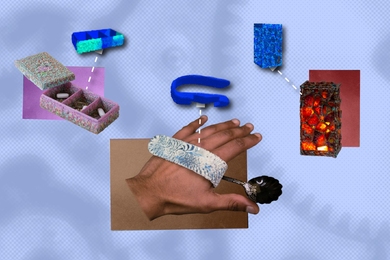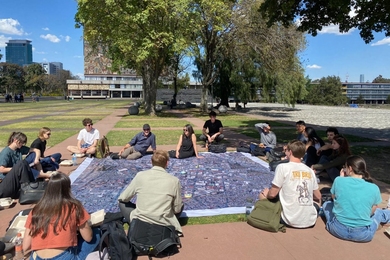In a joint exhibition opening Thursday, April 6, at the Wiesner Student Art Gallery, architecture graduate students Viktorija Abolina and Nadya Nilina explore their native lands in Eastern Europe through the lens of a camera.
For each the focus is different.
Inspired by the older wooden structures of the Latvian capital Riga, Abolina uses black-and-white photographs to create "The Portrait of Place."
"I portray the character of the place and the people that inhabit it," Abolina said, adding that she is drawn to places that are "rich and beautiful with their texture, light and composition of small details." Abolina said that she tries to explore in her photography one of the essential issues in architecture: "how the individuality of spaces relates to the people who inhabit it."
Nilina, who was born in Moscow, leans more toward social commentary in "Vanishing Landscapes of Socialism." Created with Jeff Silva, a specialist at MIT Video Productions, the exhibit is a video montage of scenes from Belgrade, Bucharest, Berlin, Leipzig, Halle and Moscow and footage from the Moscow archives from the 1950s and 1960s depicting the large housing estates erected under socialist regimes.
Nilina's photographs of the massive housing projects also set a mood, showing how these very generic spaces have become less desirable residences, vulnerable to social crisis caused by population decline and unemployment.
Both Abolina and Nilina, who did not know about each other's work until their exhibits were paired by Wiesner Gallery curators, credit the support they've received from MIT for their nontraditional projects.
"There is a lot of creativity here, including filmmaking and research and worldwide exploration," Nilina said. "The [architecture] department is truly committed to the social issues in architecture and urban planning," she adds.
"The Portrait of Place" and "Vanishing Landscapes of Socialism" are on view through Wednesday, April 26, in the Wiesner Student Art Gallery, Stratton Student Center, 2nd Floor. A concurrent exhibition by Nilina and her brother, Nilin ("Nilin & Nilina: Past Through Different Lenses") is on view at the Rotch Library Gallery (Room 7-238), also through April 26.
A version of this article appeared in MIT Tech Talk on April 5, 2006 (download PDF).







